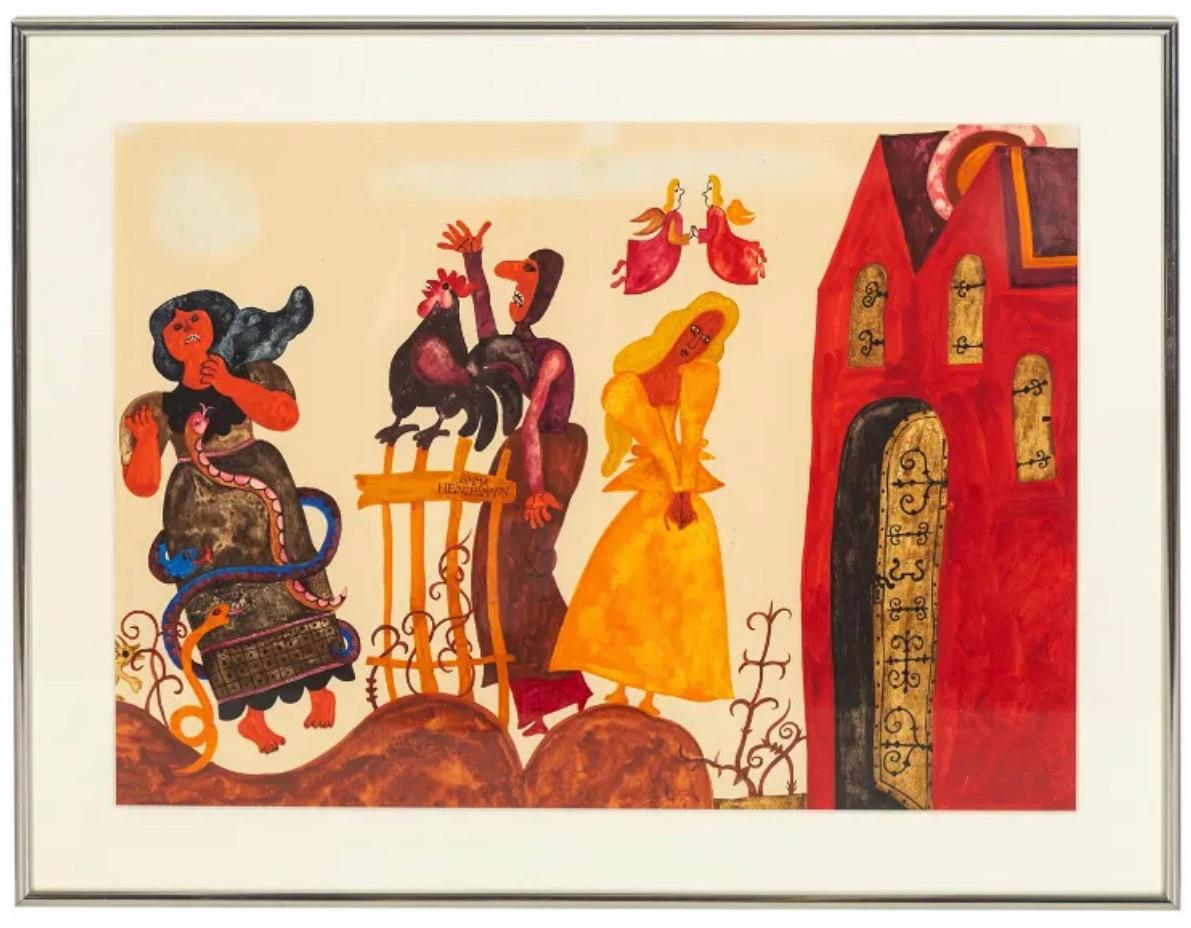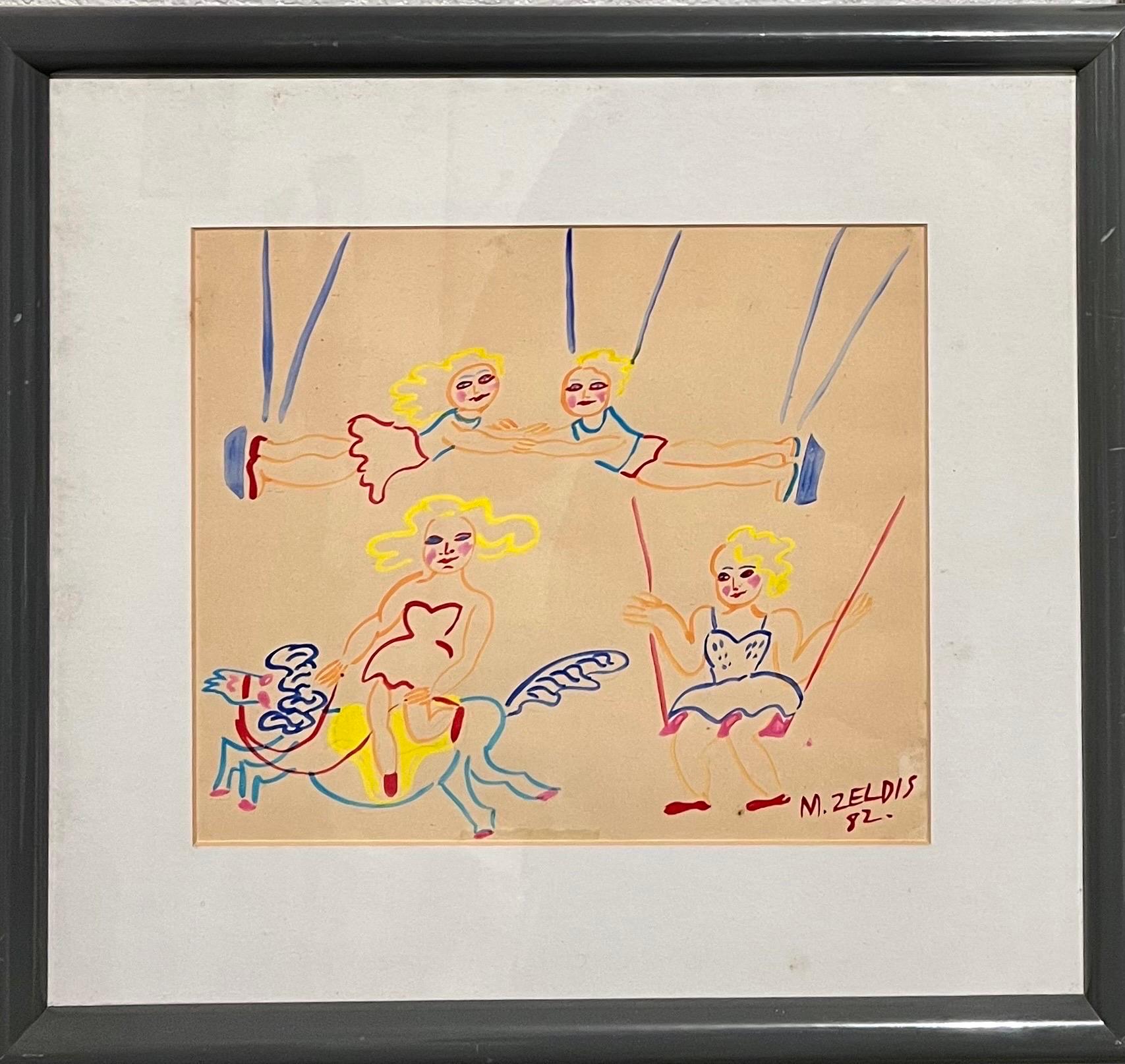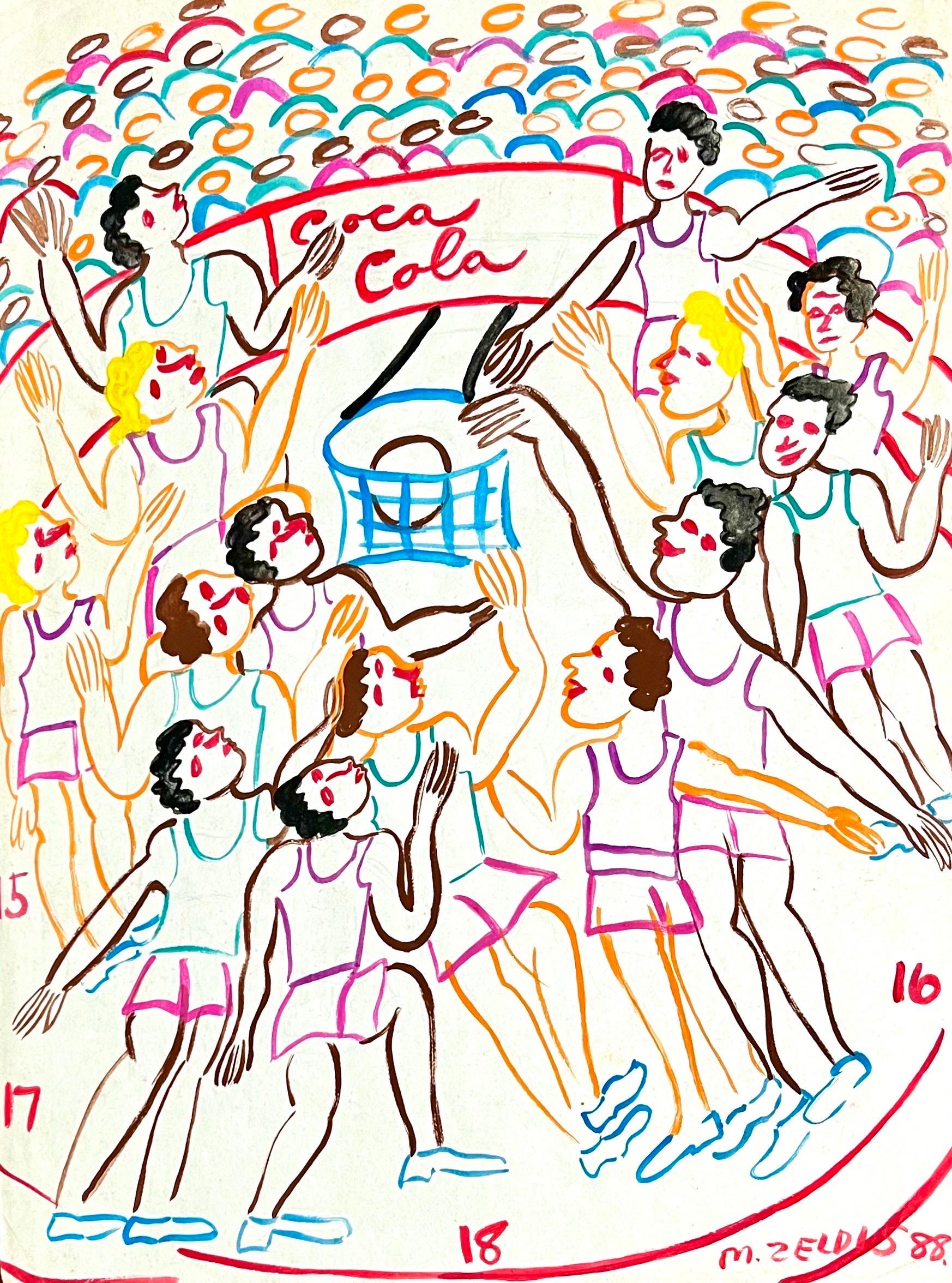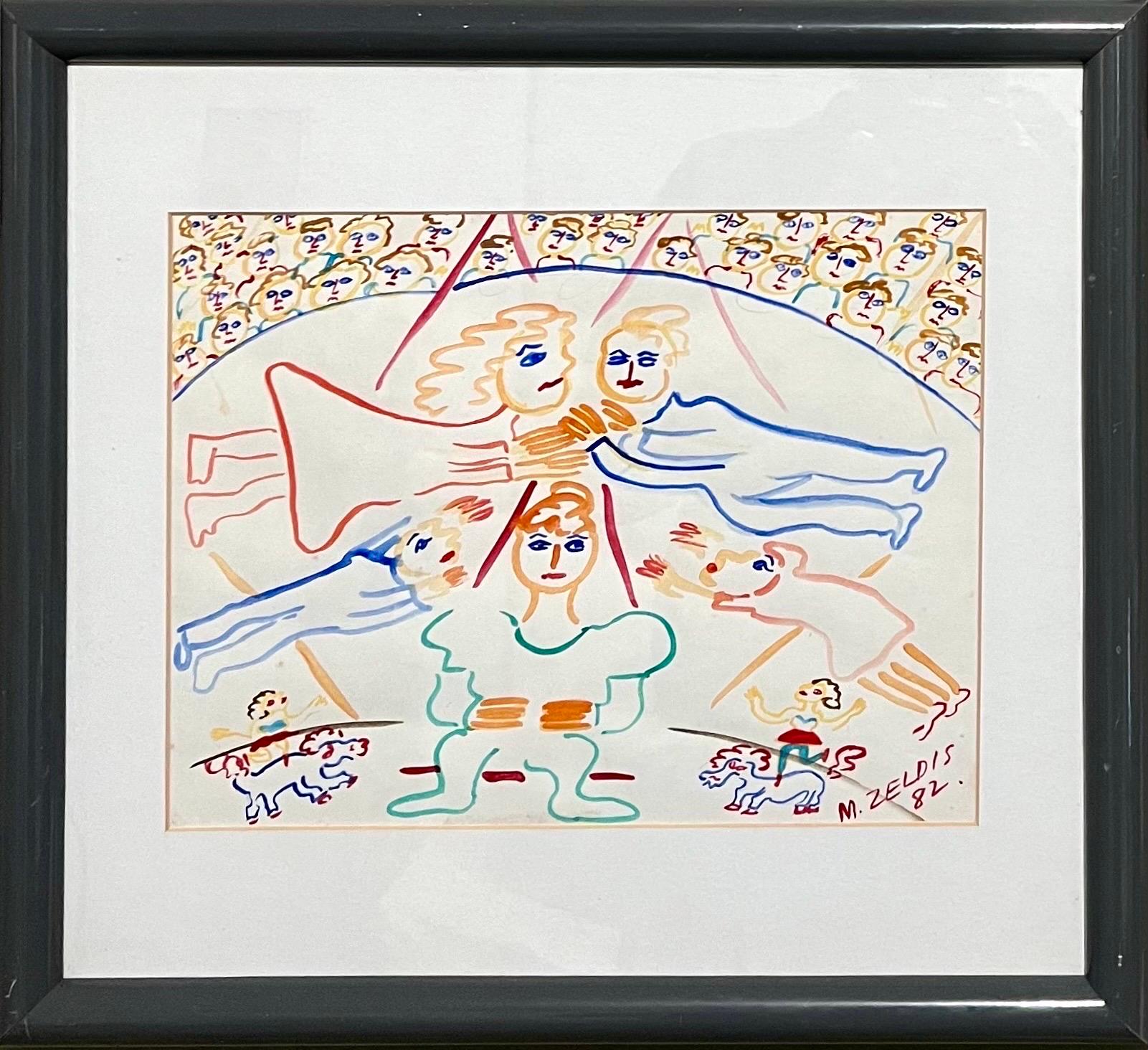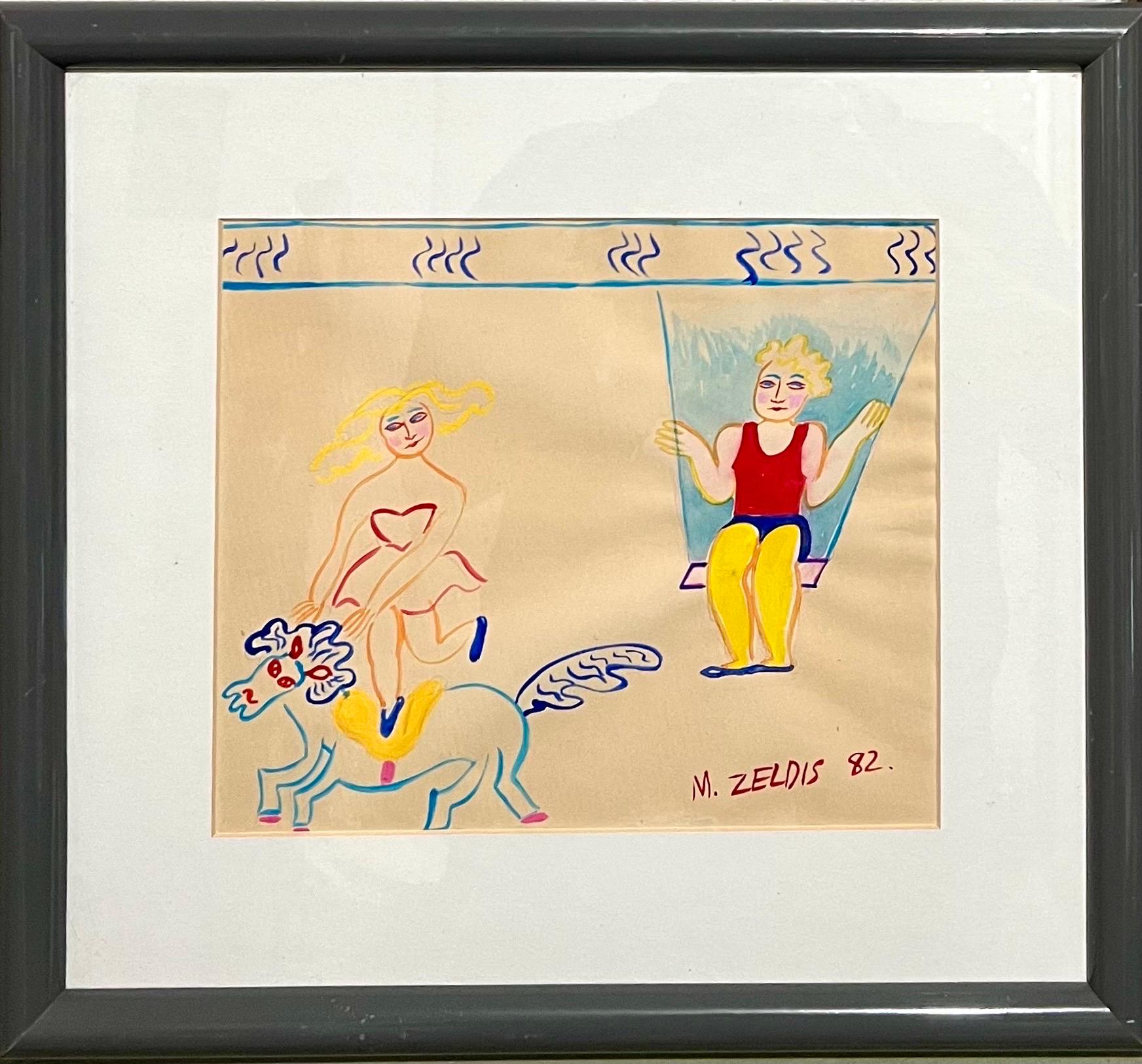Items Similar to Original Graphic Hungarian Illustration Art Emma Heinzelmann Children's Book Art
Want more images or videos?
Request additional images or videos from the seller
1 of 15
Emma HeinzelmannOriginal Graphic Hungarian Illustration Art Emma Heinzelmann Children's Book Artc.1950-1970's
c.1950-1970's
About the Item
Original vintage gouache painting on poster board by Emma Heinzelmann (Hungarian, born 1930). Hungarian Peasant art, children fairytale themes, in psychedelic pop colors of the era.This painting that depicts figures including a crowned pig, and a princess in a bed. Artist signature above bed. Housed in chrome mid century frame.
Framed: 19.5 X 25.5 image is 14.75 X 21.25.
Emma Heinzelmann ( Nyírbátor , March 14 , 1930 - ) Munkácsy Prize-winning Hungarian graphic designer and illustrator.
Heinzelmann is a Hungarian children's book illustrator and graphic poster artist, who started her career during the 1950’s. She has a very unique drawing style that resembles children’s book illustrations. Working in psychedelic pop colors of the era. She Initially she studied to be a costume designer but she soon turned to graphic design. She graduated in 1950 from the clothing design department at the Junior High School in Török Pál Street which operated under the name Szépmíves Lyceum from 1946 to 1950. His master was György Farkas, a ceramicist, painter and sculptor. She creates her compositions using mainly watercolor and gouache paint. She often worked on illustrations for children’s books, since her style fits their themes. Her posters show the same playful Hungarian Folk Art style. She has produced artwork in almost all areas of applied graphics. posters, commemorative cards, designed album covers, postcards, advertising graphics, slide films, animation and cartoons. Her drawings were published in Dörmögő Dömötör and Kisdobos among others as well as in children's magazines. An entire generation of children grew up with her book illustrations, reading the fairy tales of Wilhelm Hauff or Hans Christian Andersen. Her story books and drawings are known well beyond our borders. She illustrated nearly 80 storybooks. She is a contemporary of Maurice Sendak and William Steig. Her work is of the same genre as the iconic Polish Cyrk poster artists.
In her original fine art graphics grotesque and bitter elements often prevail, her figures are playfully ironic. Her drawings are made in a variety of ways, from pencil drawings to watercolor painting to collage techniques, from decorative spot effects to lace-like line drawings. She is no stranger to a kind of Art Nouveau influence, but it is always individual. It was never beautiful, but over the years its color scheme changed, thus confirming the lines of József Somogyi quoted earlier. She had several individual exhibitions, and for more than 10 years as a member of the Papp-Gábor group, her works could be seen in Dorottya Street.
In 2009 , the book of art historian András Székely was published by Holnap Könyvkiadó under the title Emma Heinzelmann: fairy tales in the drawing.
Awards and recognitions
Lot Prize (International Poster Biennale, Warsaw) (1972)
Ministry of Culture Award (1977, 1979)
Brno Graphic Biennale (Bronze Award) (1980)
Worker's Award (1984)
Children's Book of the Year Award (1984)
IBBY Andersen Diploma (1988)
Hamburg Lifetime Achievement Award (1990)
Albert Star Award (1992)
Noémi Ferenczy Award (2005)
Munkácsy Award (1984)
Solo Exhibitions:
Thought Bookstore, Budapest (1965)
Cultural Center, Nyíregyháza (1974)
Little Gallery, Komárom (1982)
Art Gallery, Budapest. (1990)
Vác (2010)
Selected group exhibitions:
International Children's Book Fair and Exhibition, Bologna (1971-1975)
International Graphic Biennale, Brno (1966-1985)
BIB (Children's book illustration biennial), Bratislava (1970-1985)
XXXVI. Venice Biennale, Venice (1972)
ARC. International Poster Biennale, Warsaw (1972)
International Poster Triennale (B) (1972-1974)
Weekdays, graphic exhibition, (1975)
Calligraphy and typography, Institute of Cultural Relations, Budapest (1977)
"Falrahányt pea", graphic exhibition, Institute of Cultural Relations, Budapest.(1978)
International Poster Triennale (B) (1978)
National Poster Exhibitions, Art Gallery, Budapest (1978)(1980)
International Poster Exhibition (IR) (1979)
Slide films:
Fairy tales with Emma Heinzelmann's drawings:
Under the Shore (1981)
Goose Party (1981)
Take a Little Trumpet (1982)
The Bremen Town Musicians (1985)
Bunny Rabbit (1985)
Sanyi the elf and Huhú the wizard (1985)
Fool Ivanuska (1986)
Christmas Finder (1986)
The Devil's Three Golden Hairs (1986)
No More Princes (1987)
The Firearm (1988)
As a graphic designer, Emma Heinzelmann participated in the following animated films:
Tales of Crow Hill Hungarian cartoon series, (1978)
Hungarian cartoon series "Varjúdombi Gaybrözók ", (1988)
Her most important book illustrations
The Walking Shoes (1959)
World's most beautiful folk tales 1-2. (1962)
Károly Medgyesi: Thrush Nursery (1962)
Mikes Lajos.: Sanyi's Elf Book (1963)
M. Aymé: My name is not worth it (1964)
Stefánia Mándy: Book of Twins (1964)
Ilona Bartócz: Barbara Street (1966)
Grimm: Thrush Beak (1966)
Wilhelm Hauff: Hauff's Most Beautiful Tales (1966)
Green Leaf (1967)
László Hárs: Grandpa Falling from the Sky (1967)
Vera Ferra-Mikura: Twelve: not a dozen! (1968)
My First Storybook (1969)
My Second Storybook (1969)
István Csukás: Kandúr Mirr-Murr (1969)
Ferenc Móra: The Coachman (1970)
László Hárs: Jutka and the Barter Fairy (1971)
István Csukás: Finch circus, world number! (1971)
Wind Devil (1971)
Fairies, Dwarfs, Dwarves (1973)
István Csukás: Tales of the Winter Cricket (1974)
László Hárs: Full story (1974)
László Arany: Pancimanci (1974)
HC Andersen: Andersen's Most Beautiful Tales (1975)
Ede Tarbay: Tales of Crow Hill (1975)
Tibor Gyurkovics: Poem for Santa (1975)
In the Little Mist (1976)
István Kormos: The Waiter's Tailcoat Street Cats (1976)
János Csatlós: The Castle Hanging on a Golden Chain (1977)
Piss Believes (1982)
Ede Tarbay: Kunkori and the Kandúr Wizard (1984)
Attila Béres: Christmas Finder (1984)
Sándor Kányádi Worldly Mouse (1985)
Gyula Illyés: Ilók and Mihók (1986)
Sándor Kányádi: Brave Taken on a Flower (2001)
Kálmán Gyöngy: Data and signature directory of Hungarian cartoonists 1848-2007. Caricaturists, animation puppeteers and cartoonists, illustrators, portrait painters. Budapest, Ábra Kkt., 2008.
Her data is in the catalog of the Petőfi Literary Museum
Réva's New Lexicon. Main editor. Colleague István Tarsoly. Szekszárd, Babits, 1996-.
Humor encyclopedia. Ed. Miklós Kaposy. Bp., Tarsoly Publishing House, 2001.
Her style is a unique conglomerate of tradition, history, legends, heroes, old customs and folklore. It is a self-standing style, recognizable, cheerful, whimsical and a happy creation. Naïve art is any form of visual art that is created by a person who lacks the formal education and training that a professional artist undergoes (in anatomy, art history, technique, perspective, ways of seeing). Unlike folk art, naïve art does not necessarily evince a distinct cultural context or tradition. Naïve art is recognized, and often imitated, for its childlike simplicity and frankness. Paintings of this kind typically have a flat rendering style with a rudimentary expression of perspective.
One particularly influential painter of "naïve art" was Henri Rousseau (1844–1910), a French Post-Impressionist who was discovered by Pablo Picasso. Naïve art is often seen as outsider art that is by someone without formal (or little) training or degree. While this was true before the twentieth century, there are now academies for naïve art. Naïve art is now a fully recognized art genre, represented in art galleries worldwide.
Museums devoted to naïve art now exist in Kecskemét, Hungary; Riga, Latvia; Jaen, Spain; Rio de Janeiro, Brasil; Vicq France and Paris. "Primitive art" is another term often applied to art by those without formal training, but is historically more often applied to work from certain cultures that have been judged socially or technologically "primitive" by Western academia, such as Native American, sub saharan African or Pacific Island art (see Tribal art). This is distinguished from the self-conscious, "primitive" inspired movement primitivism. Another term related to (but not completely synonymous with) naïve art is folk art. There also exist the terms "naïvism" and "primitivism" which are usually applied to professional painters working in the style of naïve art (like Paul Gauguin, Mikhail Larionov, Paul Klee).
At all events, naive art can be regarded as having occupied an "official" position in the annals of twentieth-century art since - at the very latest - the publication of the Der Blaue Reiter, an almanac in 1912. Wassily Kandinsky and Franz Marc, who brought out the almanac, presented 6 reproductions of paintings by le Douanier' Rousseau (Henri Rousseau), comparing them with other pictorial examples. However, most experts agree that the year that naive art was "discovered" was 1885, when the painter Paul Signac became aware of the talents of Henri Rousseau and set about organizing exhibitions of his work in a number of prestigious galleries. The Earth Group (Grupa Zemlja) were Croatian artists, architects and intellectuals active in Zagreb from 1929 to 1935. The group included the painters Krsto Hegedušić, Edo Kovačević, Omer Mujadžić, Kamilo Ružička, Ivan Tabaković, and Oton Postružnik, the sculptors Antun Augustinčić, Frano Kršinić, and the architect Drago Ibler. A term applied to Yugoslav (Croatian) naive painters working in or around the village of Hlebine, near the Hungarian border, from about 1930. Some of the best known naive artists are Dragan Gaži, Ivan Generalić, Josip Generalić, Krsto Hegedušić, Mijo Kovačić, Ivan Lacković-Croata, Franjo Mraz, Ivan Večenaj and Mirko Virius. Camille Bombois (1883–1970) Ferdinand Cheval, known as 'le facteur Cheval' (1836–1924) Henry Darger (1892–1973) L. S. Lowry (1887–1976) Grandma Moses, Anna Mary Robertson (1860–1961) Nikifor (1895–1968) Poland, Horace Pippin (1888–1946) Jon Serl (1894-1993) United States Alfred Wallis (1855–1942) Scottie Wilson (1890–1972) Gesner Abelard (b. 1922) Jan Balet (1913–2009) Michel Delacroix (b. 1933) France Howard Finster (1916–2001) Ivan Rabuzin (1921–2008)
Spontaneous Art Museum in Brussels
Art en Marge Museum in Brussels
MADmusée in Liege
International Museum of Naive Art of Brazil in Cosme Velho, Rio de Janeiro
Gallery Jacques Ardies in São Paulo
Musée international d'art naïf de Magog in Magog
Croatian Museum of Naïve Art in Zagreb
Gallery of Croatian Naïve Art in Zagreb
Croatian Naive Art Museum in Hlebine
Musée international d'Art naïf Anatole Jakovsky in Nice
Musée d'Art Naïf - Max Fourny in Paris
International Museum of Naive Art in Vicq (near Versailles)
Museum of Naive Art in Beraut (near Toulouse)
Museum Charlotte Zander in Bönnigheim
Gesellschaft für Naive Kunst in Hannover
Museum of Hungarian Naive Artists in Kecskemét
Gallery of International Naïve Art (GINA) in Tel Aviv
Naive Art Museum in Moscow
Collection of naïve and outsider art of Dr. X. Bogucharskaia and A.Turchin
Anthony Petullo Collection of Self-Taught & Outsider Art
American Visionary Art Museum in Baltimore, MD
- Creator:Emma Heinzelmann (1930, Hungarian)
- Creation Year:c.1950-1970's
- Dimensions:Height: 19.5 in (49.53 cm)Width: 25.5 in (64.77 cm)
- Medium:
- Movement & Style:
- Period:
- Condition:Good. Minor wear commensurate with age. please see photos.
- Gallery Location:Surfside, FL
- Reference Number:1stDibs: LU38211083862
About the Seller
4.9
Platinum Seller
These expertly vetted sellers are 1stDibs' most experienced sellers and are rated highest by our customers.
Established in 1995
1stDibs seller since 2014
1,546 sales on 1stDibs
Typical response time: 1 hour
- ShippingRetrieving quote...Ships From: Surfside, FL
- Return PolicyA return for this item may be initiated within 3 days of delivery.
More From This SellerView All
- Original Graphic Hungarian Illustration Art Emma Heinzelmann Children's Book ArtLocated in Surfside, FLOriginal vintage gouache painting on poster board by Emma Heinzelmann (Hungarian, born 1930). Hungarian Peasant art, children fairytale themes, in psychedelic pop colors of the era. This framed painting depicts figures, a rooster and angels in flying above. Artist signature on farm gate. Housed in chrome mid century frame. Framed: 19.5 X 25.5 image is 15 X 21. Emma Heinzelmann ( Nyírbátor , March 14 , 1930 - ) Munkácsy Prize-winning Hungarian graphic designer and illustrator. Heinzelmann is a Hungarian children's book illustrator and graphic poster artist, who started her career during the 1950’s. She has a very unique drawing style that resembles children’s book illustrations. Working in psychedelic pop colors of the era. She Initially she studied to be a costume designer but she soon turned to graphic design. She graduated in 1950 from the clothing design department at the Junior High School in Török Pál Street which operated under the name Szépmíves Lyceum from 1946 to 1950. His master was György Farkas, a ceramicist, painter and sculptor. She creates her compositions using mainly watercolor and gouache paint. She often worked on illustrations for children’s books, since her style fits their themes. Her posters show the same playful Hungarian Folk Art style. She has produced artwork in almost all areas of applied graphics. posters, commemorative cards, designed album covers, postcards, advertising graphics, slide films, animation and cartoons. Her drawings were published in Dörmögő Dömötör and Kisdobos among others as well as in children's magazines. An entire generation of children grew up with her book illustrations, reading the fairy tales of Wilhelm Hauff or Hans Christian Andersen. Her story books and drawings are known well beyond our borders. She illustrated nearly 80 storybooks. She is a contemporary of Maurice Sendak and William Steig. Her work is of the same genre as the iconic Polish Cyrk poster artists. In her original fine art graphics grotesque and bitter elements often prevail, her figures are playfully ironic. Her drawings are made in a variety of ways, from pencil drawings to watercolor painting to collage techniques, from decorative spot effects to lace-like line drawings. She is no stranger to a kind of Art Nouveau influence, but it is always individual. It was never beautiful, but over the years its color scheme changed, thus confirming the lines of József Somogyi quoted earlier. She had several individual exhibitions, and for more than 10 years as a member of the Papp-Gábor group, her works could be seen in Dorottya Street. In 2009 , the book of art historian András Székely was published by Holnap Könyvkiadó under the title Emma Heinzelmann: fairy tales in the drawing. Awards and recognitions Lot Prize (International Poster Biennale, Warsaw) (1972) Ministry of Culture Award (1977, 1979) Brno Graphic Biennale (Bronze Award) (1980) Worker's Award (1984) Children's Book of the Year Award (1984) IBBY Andersen Diploma (1988) Hamburg Lifetime Achievement Award (1990) Albert Star Award (1992) Noémi Ferenczy Award (2005) Munkácsy Award (1984) Solo Exhibitions: Thought Bookstore, Budapest (1965) Cultural Center, Nyíregyháza (1974) Little Gallery, Komárom (1982) Art Gallery, Budapest. (1990) Vác (2010) Selected group exhibitions: International Children's Book Fair and Exhibition, Bologna (1971-1975) International Graphic Biennale, Brno (1966-1985) BIB (Children's book illustration biennial), Bratislava (1970-1985) XXXVI. Venice Biennale, Venice (1972) ARC. International Poster Biennale, Warsaw (1972) International Poster Triennale (B) (1972-1974) Weekdays, graphic exhibition, (1975) Calligraphy and typography, Institute of Cultural Relations, Budapest (1977) "Falrahányt pea", graphic exhibition, Institute of Cultural Relations, Budapest.(1978) International Poster Triennale (B) (1978) National Poster Exhibitions, Art Gallery, Budapest (1978)(1980) International Poster Exhibition (IR) (1979) Slide films: Fairy tales with Emma Heinzelmann's drawings: Under the Shore (1981) Goose Party (1981) Take a Little Trumpet (1982) The Bremen Town...Category
Mid-20th Century Folk Art Figurative Paintings
MaterialsGouache
- Malcah Zeldis Folk Art Gouache Painting Outsider Circus Trapeze Horse AcrobatsLocated in Surfside, FLMALCAH ZELDIS Circus, Trapeze Artists, Horse rider and Acrobats gouache on paper Hand signed and dated bottom right. titled in pencil on paper verso. Fr...Category
1980s Folk Art Figurative Paintings
MaterialsPaper, Gouache
- Malcah Zeldis Folk Art Gouache Painting Outsider Circus Trapeze Horse AcrobatsLocated in Surfside, FLMALCAH ZELDIS Circus, Trapeze Artists, Horse rider and Acrobats gouache on paper Hand signed and dated bottom right. titled in pencil on paper verso. Fr...Category
1980s Folk Art Figurative Paintings
MaterialsPaper, Gouache
- Malcah Zeldis Folk Art Gouache Painting Sports Basketball Arena Coca Cola SignLocated in Surfside, FLMALCAH ZELDIS ''Basketball'', 1988, gouache on paper Hand signed and dated bottom right, titled in pencil on paper verso Malcah Zeldis (born Mildred ...Category
1980s Folk Art Figurative Paintings
MaterialsPaper, Gouache
- Malcah Zeldis Folk Art Gouache Painting Outsider Circus Trapeze Artist AcrobatsLocated in Surfside, FLMALCAH ZELDIS Circus, Trapeze Artists and Acrobats gouache on paper Hand signed and dated bottom right. titled in pencil on paper verso. Framed to 15 X ...Category
1980s Folk Art Figurative Paintings
MaterialsPaper, Gouache
- Malcah Zeldis Folk Art Gouache Painting Wine & Cigarettes Woman Outsider ArtistLocated in Surfside, FLMALCAH ZELDIS Reclining Woman Wine and Cigarettes gouache on paper Hand signed and dated bottom right. titled in pencil on paper verso. Matted to 13 X 1...Category
1980s Folk Art Figurative Paintings
MaterialsPaper, Gouache
You May Also Like
- "The People People 5, " Paint on Paper, 2006Located in Chicago, ILIn this series entitled "The People People," Tracy Crump uses washes of grey, white and aqua to both conceal and reveal sensitively drawn figures. Each figure stands alone as an indi...Category
21st Century and Contemporary Outsider Art Figurative Drawings and Water...
MaterialsPaper, Ink, Acrylic, Watercolor
- "The People People 6" by Tracy CrumpLocated in Chicago, ILIn this series entitled "The People People," Tracy Crump uses washes of white, red and aqua to both conceal and reveal sensitively drawn figures. Each fig...Category
21st Century and Contemporary Outsider Art Figurative Drawings and Water...
MaterialsPaper, Ink, Acrylic, Watercolor
- "The People People 4, " Acrylic Paint and Watercolor on Paper, 2006Located in Chicago, ILIn this series entitled "The People People," Tracy Crump uses washes of grey, white and aqua to both conceal and reveal sensitively drawn figures. Each figure stands alone as an indi...Category
21st Century and Contemporary Outsider Art Figurative Drawings and Water...
MaterialsPaper, Ink, Acrylic, Watercolor
- 'The People People 2, " Acrylic Paint on Canvas, 2006Located in Chicago, ILIn this series entitled "The People People," Tracy Crump uses washes of grey, white and aqua to both conceal and reveal sensitively drawn figures. Each figure stands alone as an indi...Category
21st Century and Contemporary Outsider Art Figurative Drawings and Water...
MaterialsPaper, Ink, Acrylic, Watercolor
- The Abduction of the Sabine Women , a Renaissance drawing by Biagio PupiniLocated in PARIS, FRThis vigorous drawing has long been attributed to Polidoro da Caravaggio: The Abduction of the Sabine Women is one of the scenes that Polidoro depicted between 1525 and 1527 on the façade of the Milesi Palazzo in Rome. However, the proximity to another drawing inspired by this same façade, kept at the Ecole des Beaux-Arts, and to other drawings inspired by Polidoro kept at the Musée du Louvre, leads us to propose an attribution to Biagio Pupini, a Bolognese artist whose life remains barely known, despite the abundant number of drawings attributed to him. 1. Biagio Pupini, a Bolognese artist in the light of the Roman Renaissance The early life of Biagio Pupini, an important figure of the first half of the Cinquecento in Bologna - Vasari mentions him several times - is still poorly known. Neither his date of birth (probably around 1490-1495) nor his training are known. He is said to have been a pupil of Francesco Francia (1450 - 1517) and his name appears for the first time in 1511 in a contract with the painter Bagnacavallo (c. 1484 - 1542) for the frescoes of a church in Faenza. He then collaborated with Girolamo da Carpi, at San Michele in Bosco and at the villa of Belriguardo. He must have gone to Rome for the first time with Bagnacavallo between 1511 and 1519. There he discovered the art of Raphael, with whom he might have worked, and that of Polidoro da Caravaggio. This first visit, and those that followed, were the occasion for an intense study of ancient and modern art, as illustrated by his abundant graphic production. Polidoro da Caravaggio had a particular influence on the technique adopted by Pupini. Executed on coloured paper, his drawings generally combine pen, brown ink and wash with abundant highlights of white gouache, as in the drawing presented here. 2. The Abduction of the Sabine Women Our drawing is an adaptation of a fresco painted between 1525 and 1527 by Polidoro da Caravaggio on the façade of the Milesi Palace in Rome. These painted façades were very famous from the moment they were painted and inspired many artists during their stay in Rome. These frescoes are now very deteriorated and difficult to see, as the palace is in a rather narrow street. The episode of the abduction of the Sabine women (which appears in the centre of the photo above) is a historical theme that goes back to the origins of Rome and is recounted both by Titus Livius (Ab Urbe condita I,13), by Ovid (Fasti III, 199-228) and by Plutarch (II, Romulus 14-19). After killing his twin brother Romus, Romulus populates the city of Rome by opening it up to refugees and brigands and finds himself with an excess of men. Because of their reputation, none of the inhabitants of the neighbouring cities want to give them their daughters in marriage. The Romans then decide to invite their Sabine neighbours to a great feast during which they slaughter the Sabines and kidnap their daughters. The engraving made by Giovanni Battista Gallestruzzi (1618 - 1677) around 1656-1658 gives us a good understanding of the Polidoro fresco, allowing us to see how Biagio Pupini reworked the scene to extract this dynamic group. With a remarkable economy of means, Biagio Pupini takes over the left-hand side of the fresco and depicts in a very dense space two main groups, each consisting of a Roman and a Sabine, completed by a group of three soldiers in the background (which seems to differ quite significantly from Polidoro's composition). The balance of the drawing is based on a very strongly structured composition. The drawing is organised around a median vertical axis, which runs along both the elbow of the kidnapped Sabine on the left and the foot of her captor, and the two main diagonals, reinforced by four secondary diagonals. This diamond-shaped structure creates an extremely dynamic space, in which centripetal movements (the legs of the Sabine on the right, the arm of the soldier on the back at the top right) and centrifugal movements (the arm of the kidnapper on the left and the legs of the Sabine he is carrying away, the arm of the Sabine on the right) oppose each other, giving the drawing the appearance of a whirlpool around a central point of support situated slightly to the left of the navel of the kidnapper on the right. 3. Polidoro da Caravaggio, and the decorations of Roman palaces Polidoro da Caravaggio was a paradoxical artist who entered Raphael's (1483 - 1520) workshop at a very young age, when he oversaw the Lodges in the Vatican. Most of his Roman work, which was the peak of his career, has disappeared, as he specialised in facade painting, and yet these paintings, which are eminently visible in urban spaces, have influenced generations of artists who copied them abundantly during their visits to Rome. Polidoro Caldara was born in Caravaggio around 1495-1500 (the birthplace of Michelangelo Merisi, known as Caravaggio, who was born there in 1571), some forty kilometres east of Milan. According to Vasari, he arrived as a mason on the Vatican's construction site and joined Raphael's workshop around 1517 (at the age of eighteen according to Vasari). This integration would have allowed Polidoro to work not only on the frescoes of the Lodges, but also on some of the frescoes of the Chambers, as well as on the flat of Cardinal Bibiena in the Vatican. After Raphael's death in 1520, Polidoro worked first with Perin del Vaga before joining forces with Maturino of Florence (1490 - 1528), whom he had also known in Raphael's workshop. Together they specialised in the painting of palace façades. They were to produce some forty façades decorated with grisaille paintings imitating antique bas-reliefs. The Sack of Rome in 1527, during which his friend Maturino was killed, led Polidoro to flee first to Naples (where he had already stayed in 1523), then to Messina. It was while he was preparing his return to the peninsula that he was murdered by one of his assistants, Tonno Calabrese, in 1543. In his Vite, Vasari celebrated Polidoro as the greatest façade decorator of his time, noting that "there is no flat, palace, garden or villa in Rome that does not contain a work by Polidoro". Polidoro's facade decorations, most of which have disappeared as they were displayed in the open air, constitute the most important lost chapter of Roman art of the Cinquecento. The few surviving drawings of the painter can, however, give an idea of the original appearance of his murals and show that he was an artist of remarkable and highly original genius. 4. The façade of the Milesi Palace Giovanni Antonio Milesi, who commissioned this palace, located not far from the Tiber, north of Piazza Navona, was a native of the Bergamo area, like Polidoro, with whom he maintained close friendly ties. Executed in the last years before the Sack of Rome, around 1526-1527, the decoration of Palazzo Milesi is considered Polidoro's greatest decorative success. An engraving by Ernesto Maccari made at the end of the nineteenth century allows us to understand the general balance of this façade, which was still well preserved at the time. The frescoes were not entirely monochrome, but alternated elements in chiaroscuro simulating marble bas-reliefs and those in ochre simulating bronze and gold vases...Category
16th Century Old Masters Figurative Drawings and Watercolors
MaterialsInk, Gouache, Pen
- Oleg (Kimono), Mixed media on ochre parchment paperBy Howard TangyeLocated in London, GBHoward Tangye (b.1948, Australia) has been an influential force in fashion for decades. Lecturing at London’s Central Saint Martins for 35 years, including 16 years as head of BA Wom...Category
2010s Contemporary Figurative Drawings and Watercolors
MaterialsPaint, Paper, Parchment Paper, Charcoal, Crayon, Oil Crayon, Oil Pastel,...
